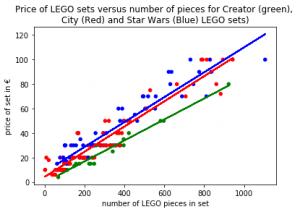The value of a brand: LEGO Star Wars sets are €4 more expensive than LEGO City sets
Having recently spend time in three different LEGO shops in the same number of days, I started to notice that the LEGO Star Wars sets were slightly higher priced compared to equally sized "normal" LEGO sets (ie, LEGO City and LEGO Creator). This makes sense, since LEGO most likely has to pay Disney licensing rights to use the Star Wars brand. All other costs in making these sets should be the same (I think).
I wonder if I could quantify how much more one pays for a Star Wars set, compared to a normal LEGO set. If I can quantify this difference, it will tell us how much more the LEGO company thinks people are willing to spend on Star Wars LEGO versus normal LEGO and (thus) how much the (LEGO part of the) Star Wars brand is "worth".
Methods
Just simply comparing the average prices for all LEGO Star Wars sets compared to the normal sets will not work: most Star Wars sets are larger than normal sets and larger sets are more expensive. To analyse this I need information on both the size, as well as the price of all sets. Online I found these at brickset.com. For the years 2016-2018 I select all Star Wars, Creator and City sets and download the information into csv files (available with this notebook). Then I create a single pandas data frame to hold all the information.
I will try to fit a one dimensional linear regression model (ie. a straight line) between the number of pieces and the price of the set. I'm trying to see if the LEGO Star Wars sets are significantly different in price compared to the City and Creator sets. To test this I will look at the difference in base price, divided by the joint uncertainty in the estimation of those base prices. When this ratio is bigger than one, my hypothesis that LEGO Star Wars sets are more expensive than LEGO City sets is supported by the data.
To make sure that very big sets (ie. outliers) do not influence the analyses too much (looking at you Millenium Falcon Collectors Edition), sets of more than €100 are excluded. Since the datasets also contains collectables like keychains and other things not made of LEGO bricks, I also excluded all items with number of pieces lower than 1.
Results

Price of LEGO sets versus number of pieces in each set for LEGO Creator (green), LEGO City (red) and LEGO Star Wars (blue)
The figure to the right shows all datapoints from the dataset and all fitted lines. The different colours are red for the "City" LEGO sets, green for "Creator" LEGO sets and finally blue for "Star Wars" LEGO sets. The line for the "City" sets and the "Star Wars" sets have a remarkable similar slope: the price per piece (brick) is nearly the same. The blue line is higher than both the red and green one, indicating that indeed the price of LEGO Star Wars sets is higher than those of City and Creator sets.
Statistical analyses results
The bias in those fits, ie. the fixed price per set is €8.36 for the Star Wars LEGO sets and €4.28 for the LEGO sets. The difference of €4.04 divided by the joint uncertainty in this estimates is 1.7, indicating that those base prices differ strongly given the uncertainty in the data set.
A post hoc analyses
I found the difference in the slope (price per piece) of the Creator (green line) and City (red line) surprising. This difference divided by the joint uncertainty is 3.3. For some reason the price per piece for the Creator sub-brand is at 8.6 euro-cent per piece lower than for the City sub-brand (at 10.3 euro-cent per piece)
Conclusions and discussion
The analyses supports my initial belief that the Star Wars LEGO sets are more expensive than the City and Creator sets. While the price per piece is identical for LEGO City and LEGO Star Wars sets, the base price per set is €4.04 higher for LEGO Star Wars sets. While analysing the data I also found that the price per piece for the LEGO Creator sets is much lower at 8.6 eurocents per piece compared to the LEGO City set at 10.3 eurocents per piece.
What the reasons for these differences are is not examined in this analyses, I only look at the sales price. Wether the increased base price of the LEGO Star Wars sets is because LEGO has to pay a license to Disney of €4 per box, or wether the LEGO company has done extensive market research and concluded that LEGO Star Wars fans are, on average, willing to pay €4 more for the same amount of bricks, cannot be separated in this analyses. The same holds for the lower price per piece for the creator set. My partner argues that most Creator sets contain more small basic pieces that are cheaper to produce compared to the larger complex pieces in the LEGO and City sets. It can also be argued that City sets are more often bought as presents for kids where (the larger) Creator sets are bought by adult fans of LEGO. The willingness to pay could be different for those groups.
This analyses has supported my initial observation: LEGO Star Wars sets are more expansive than LEGO City sets. While the price per piece is similar at 10.3 euro-cents per piece, the base price is €4.04 higher at €8.36 for LEGO Star Wars sets.
Citation
If you want to reference or cite this work, please use this DOI:
- Blogs (163)
- Digitale data en economie (19)
- Geek en/of nerd (35)
- Onderwijs en politiek (40)
- Overig (34)
- Tinkering (knutselen) (71)
- Energie overdenkingen (1)
- English (39)
- forwardingPages (6)
- In de media (70)
- Huts Koffer, Volkskrant (36)
- overige media optredens (20)
- Radio 1: nieuws en co (12)
- Nieuws (168)
- Terugluisteren (8)
- Wetenschap (45)
- andermans werk (5)
- eigen werk (35)
- Blogs (163)

